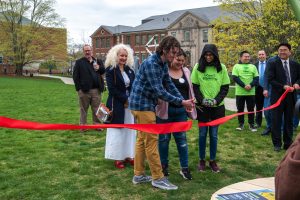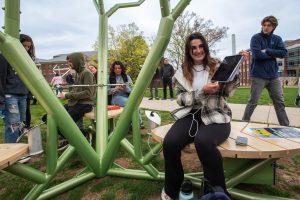UConn held a ribbon-cutting ceremony on Wednesday afternoon for a solar-powered STEAM tree that will allow community members to charge their personal devices as they enjoy time on the Student Union Mall.
The “tree” consists of a metal base that supports panels to look like an actual tree. The solar power generated from the panels is stored in batteries, which allows users to charge devices, like phones and laptop computers. The technology is common in Europe and Asia, with growing numbers of solar trees in the United States.

The UConn project is known as a “STEAM” tree because it combines the skills of University members from the fields of science, technology, engineering, arts, and mathematics.
“This is about more than just solar power, batteries and clean energy – it is really about the mindfulness that comes from being together in nature,” said UConn President Radenka Maric. “It’s about feeling connected to each other and celebrating our creativity and a sense of team spirit. I am looking forward to more initiatives like this at UConn that we are going to bring to the community.”
The dedication was part of UConn’s Earth Day Spring Fling, which included a number of sustainable events – mostly located on Fairfield Way. UConn Dining Services provided a Zero Waste BBQ, while other activities included an environmental art show, outdoor yoga, and the annual Class Tree Planting.
The concept for a STEAM tree at UConn started with a meeting Assistant Professor of Material Science and Engineering Jasna Jaknovic had with Assistant Dean for Research and Graduate Education in the School of Engineering Leslie Shor.
“Leslie asked me what my vision was for UConn’s future and I talked about clean energy,” said Jaknovic. “She also asked me about my dream for UConn and I told her about a solar tree and she encouraged me to apply for a STEAM grant, we received it and here we are today.”
The STEAM Innovation Grant at UConn is administered by the Office of the Vice President for Research and the School of Fine Arts to encourage innovative collaborations between the arts and STEM disciplines.
Funding for the STEAM tree also came from the Krenicki Arts and Engineering Institute at UConn and the solar panels and batteries were donated by Renogy solar. The Center for Clean Energy Engineering was also instrumental in supporting the project.

“One of the things that interested me in coming to UConn as a creative researcher and an educator was the opportunity to work with people on a project like this in a creative and interdisciplinary way,” said Chris Sancomb, an assistant professor in the Industrial Design program in the School of Fine Arts. “One of my goals for this project has been to share how art and design can contribute to research beyond beautification. Design as a practice is primed to facilitate collaboration and implementation through creative problem solving, innovation, technology, and engineering. Design is essential for this type of work, and can help to create partnerships such as ours, that can help envision an alternative sustainable future.”
In addition to Jaknovic and Sancomb, other faculty members involved were: Associate Professor of Engineering Sung-Yeul Park, Professor of Ecology and Evolutionary Biology Cynthia Jones and Professor of Urban and Community Studies Stacy Maddern.
A number of UConn undergraduate and graduate students were involved in the project along with high school students.


